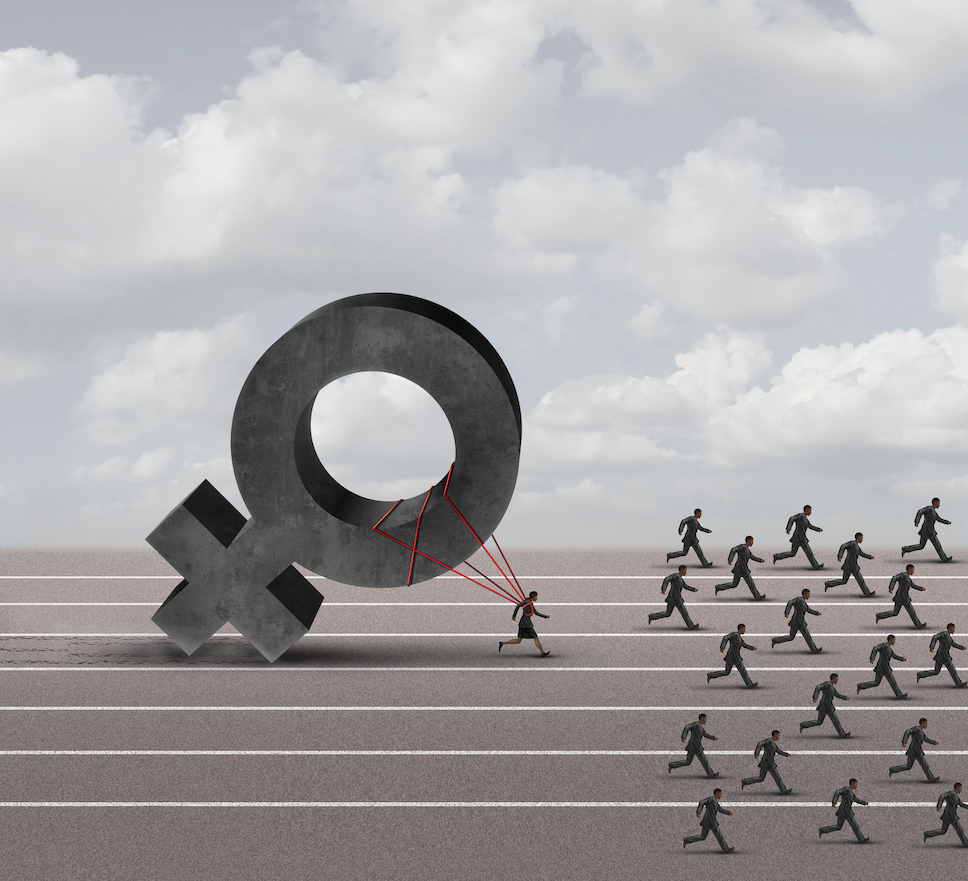In the 21st century (from 2000-2022), women have seen a dramatic rise in the workplace. Compelling societal and workplace trends indicate women are a rising force and gaining more power.
- Women Earn More Bachelor’s Degrees Than Men
- More Mothers Than Ever Are Primary or Sole Earners In Their Household
- 40% of US businesses are women-owned businesses.
These trends indicate that women are gaining agency, power, and flow. They are shaping workplace cultures to be more inclusive and include a greater sense of belonging. And yet, with so much progress, persistent headwinds resist these social and cultural evolutionary changes. This resistance can be summarized in two words: gender bias.
What is gender bias?

Sexism discrimination concept as a struggling woman with the burden of pulling a heavy female 3D illustration symbol falling behind a group of running businessmen or men as an unfair gender bias.
Gender bias is the tendency to prefer one gender over another. It is a form of unconscious or implicit bias that occurs when a man or woman unconsciously attributes certain attitudes and stereotypes to another man or woman based on their gender. These ascribed behaviors affect how the individual understands and engages with others, including and especially in the workplace.
CONTEXTUAL NOTE: Gender bias is typically thought of in binary terms — male and female — emphasizing the negative impact this bias has on women in the workplace. This is a good lens to examine and can expose structural inequities. Still, it falls short over time, leaving out the broader spectrum of gender identities and the many dimensions of diversity. Ultimately, it contributes to and creates more problems rather than solving existing ones.
4 Unconscious Gender Bias Examples in the Workplace
Below, we discuss four common examples of how four well-researched forms of gender bias negatively impact women in the workplace. The stories reveal how bias has evolved despite the significant societal and workplace trends serving to empower and liberate women.
Olivia is a female executive of a large organization representing clients in a heavily male-dominated (construction) industry. She was hired as the organization’s youngest director at 26 and ascended to an executive role at age 33. I invited her to share her first-person experiences and perspective on gender bias in the workplace. Our Q&A is included below.
The Tightrope Bias

Assured smiley woman walking on the rope over dark background.
The tightrope bias is the double standard women in the workplace face in balancing being likable with being competent. Women who are assertive with their opinions are more likely to be referred to as “bossy” or “pushy,” whereas a man is more likely to be described as “take-charge” or “self-motivated.” Women are expected to balance “masculine” qualities such as assertiveness, ambition, and competitiveness with “feminine” qualities such as caring, modest, or nice. This constant balancing act creates a direct disadvantage for women as they struggle to navigate the professional ladder.
Q: How have you navigated the tightrope bias throughout your career?
Olivia: For the first five years of my career, I was constantly navigating how to be taken seriously as a leader and achiever, with being ‘likable’ and ‘delightful.’ The men I work with don’t have to think about this. For women, the tightrope is something we learn early on and can feel relentless. After more than a decade in my career, I still think carefully about my tone, my style, and how I present ideas to a room full of men. I don’t want to come off as too ‘bossy’ or ‘off-putting.’ ”
Prove-It Again–Bias
The Prove-It-Again Bias occurs when people automatically associate high-ranking positions with a man. A key component of Prove-It Again Bias is that men’s and women’s successes are interpreted differently. For example, men’s accomplishments tend to be attributed to skill, while women’s are often attributed to luck or an external circumstance. Conversely, mistakes made by women in the workplace tend to be noticed more and remembered longer than their male counterparts. With Prove-It-Again Bias, women are more likely to be promoted on their performance, while men are promoted on their potential.
Q: Have you experienced the Prove-It-Again Bias, and if so, how has it impacted your career?
Olivia: “For years, not a day would go by that I didn’t feel like I had to perform at 100% to prove I belonged there. That women belonged there. Society generally doesn’t view women as ‘natural leaders,’ and I think we inherently know this. At the beginning of my career, no matter how much I achieved for the company (and I achieved a lot), I was terrified of making a mistake or failing at any level because I worried people would only see that one failure. I am often the only woman in the board room, C Suite, and client meetings, so I stood out like a sore thumb early on. It took me twice as long to earn the respect of my male peers and clients than it would have had I been a man.”
Maternal Wall Bias
Society still maintains the bias that women can’t be good workers and mothers simultaneously. The Maternal Wall Bias stems from this belief and occurs when colleagues or bosses (consciously or unconsciously) view mothers—or pregnant women—as less competent and less committed to their jobs. Maternal wall bias can manifest in different ways across an organization, from the hiring process to peers’ assumptions, to performance evaluations. The assumptions we make about working mothers can have real and negative consequences. For example, in one study, women who did not have children were twice as likely to be called back for an interview as similarly qualified women who stated that they did have children. In the same study, women with children were evaluated as less competent and committed than women without children or male counterparts and offered lower salaries. (The study also looked for similar evidence of discrimination against fathers and did not find any; if anything, the study showed that fathers fared slightly better in the hiring process than men who didn’t have children.)
Q: Does it surprise you that women without children were twice as likely to be called back for an interview as women with children?
Olivia. “It doesn’t surprise me at all. Sadly, throughout my career, I’ve been part of many hiring meetings where someone will mention the general age of the woman and then weigh the fact that she might have or want to start a family soon. I have never once heard this same conversation about a man. I think the assumption is that a mother won’t be as dedicated to her work or career. We must address that assumption head-on because it’s wrong and deeply flawed. In fact, currently, the top performers in our company all happen to be mothers, and these mothers are the top earners in their households.”
Tug-of-War Bias
The Tug-of-War Bias occurs when other kinds of gender bias fuel conflict among women. It is the result of circumstances, not personality. For example, women who have had to face the maternal wall bias, the prove-it-again bias, or the tightrope bias may exhibit those same biases against other women in the workplace. One of the most commonly noted forms of tug-of-war bias is when women are made to believe that there is only room for one woman at the top of the table.
Q: When have you experienced a tug-of-war work culture, and how did it impact you?
Olivia. “ The tug-of-war culture is a red flag for toxic, top-town leadership inside a company, and it occurs a lot within my industry. A female manager I once interviewed told me she ‘didn’t like working with women.’ I think about that a lot. In hindsight, I’ve realized that because of her own lived experiences, she held a scarcity mindset about success. In other words, she was made to believe that anytime another woman succeeded, it was a direct threat to her seat at the table. She didn’t make that up. That was her own experience within the company, and she was repeating it. The tug-of-war culture disappears when women have true equality and belonging inside a company.”
Dismantling Gender Bias in the Workplace
Q: Unconscious gender bias remains a significant barrier to women’s career advancement. It can also be challenging to identify and prevent. What is something you think company leaders can do to address and decrease gender bias in their workplace?
Olivia: My work with the Percipio Company taught me that we can’t address biases – in ourselves or others – until we become aware of them. Understanding the different types of biases and then reflecting on where and how they are showing up in your life and behavior is an essential first step. Reading articles like this one is a great place to start. From there, I think company leaders can begin to make fundamental changes to tackle gender bias and all other forms of bias. Leaders just need the right tools and the courage to use them.
4 Steps to Dismantling Gender Bias
As an organizational leader, there are four key practices you can implement within your organization to help reduce the negative impacts of gender bias:
- Look Critically At Your Bias Ecosystem. Businesses that seek to understand the bias ecosystem are more intentional in developing inclusive behaviors that foster creativity, communication, retention, high performance, and a culture of belonging. Working from a foundation that understands and address the complex bias ecosystem allows companies to mitigate against fear and defensiveness by recognizing that most people have an innate curiosity about how their brains work. From this place of curiosity, we can explore how cognitive, social, and institutional biases- including gender biases- manifest in their work relationships and corporate structures.
- Assess Company Culture & Dedicate Space for Inclusive Conversations. Have your employees take the Unconscious Bias Assessment and the Belonging Assessment. Both assessments are designed to help individuals self-reflect. From this place, you can begin to actively engage to disrupt the hidden (and not-so-hidden) biases that impact individual, team, and company performance. These conversations, when properly facilitated, strengthen employee relations.
- Create a More Structured Performance Review Process. Lack of structure in performance reviews creates more opportunities for gender biases to play a role. This is because managers (and people) too often perceive the same behaviors differently based on whether a man or woman engages in them. To help prevent unconscious gender bias, organizations should create performance-based evaluations with clear criteria and a transparent process that is applied consistently across all employees. Holding managers accountable for their reviews can also reduce the likelihood of gender stereotypes influencing the process.
- Implement DEI Practices That Foster Belonging. Gender bias is part of a larger and more complex bio ecosystem. It is also important to point out that gender bias, including through the binary “male versus female” lens, harms men too. People show up authentically when (and where) they feel like they truly belong. As a result, they perform at their highest levels. Investing in strategies that create and strengthen Diversity, Equity & Inclusion (DE&I) will create a deeper sense of belonging for all your employees and yield a powerful ROI for your company.
There are many other steps a company can take to help minimize gender bias across the institution, including supporting women in more senior roles, implementing gender-neutral recruitment processes, reviewing salaries, and establishing a clear policy on discrimination.
When organizations work to create an environment where women are equally set up to succeed, they ultimately create a workplace that is stronger and healthier for everyone. These organizations see the changes happening in the 21st Century and are empowered by them. They see the changing gender landscape and get excited about chartering unknown courses, establishing new norms, and embracing a world that celebrates the empowerment, leadership, and accomplishments of women.

Percipio Company is led by Matthew Cahill. His deep expertise in cognitive, social, and workplace biases is rooted in the belief that if you have a brain, you have bias®. He works with executives to reduce mental mistakes, strengthen workplace relationships & disrupt existing bias within current HR processes, meeting protocols and corporate policies. Matthew has demonstrated success with large clients like LinkedIn, Salesforce and dozens of small to mid-size companies looking to create more inclusive workplaces, work smarter, generate more revenue and move from bias to belonging®.





